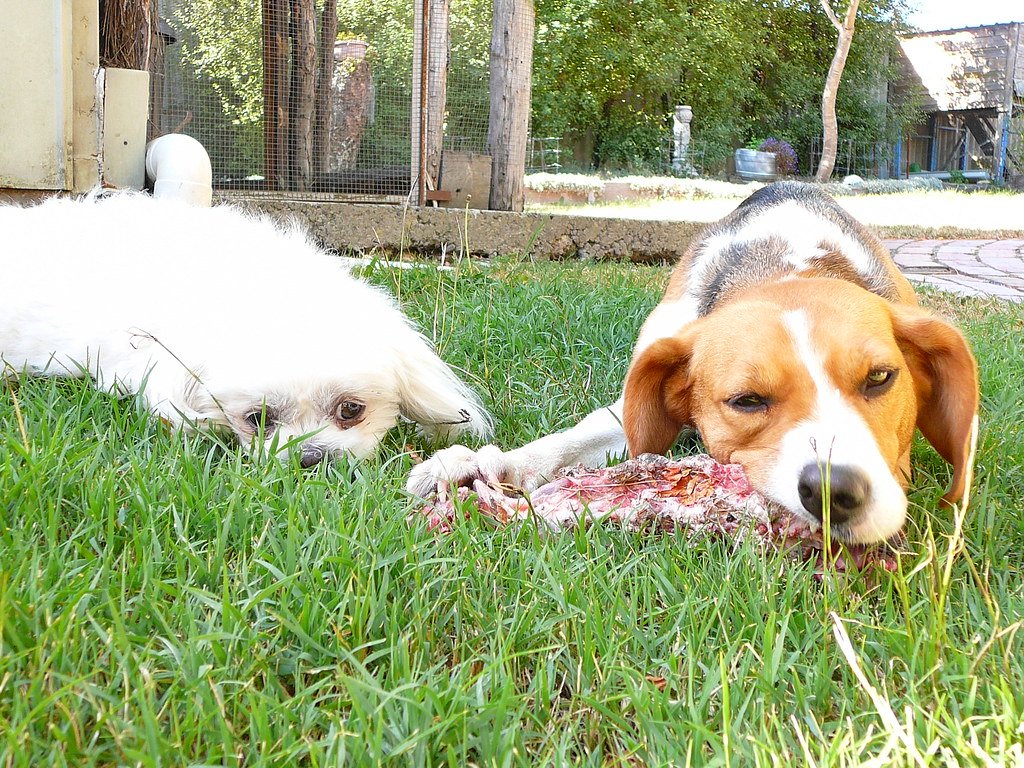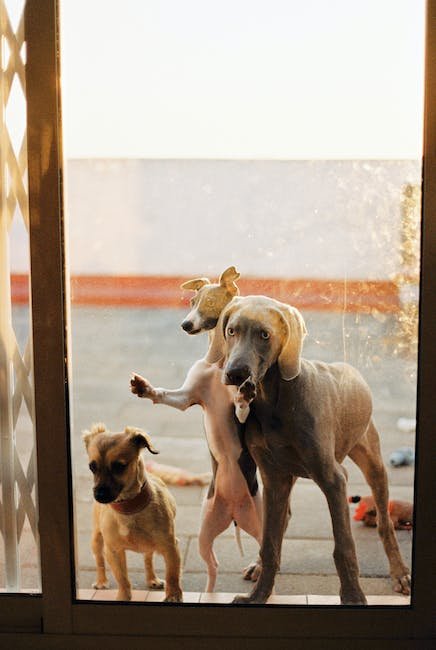Jealousy can be a powerful emotion, not exclusive to humans but also present in our beloved canine companions. Dogs are known for their loyalty and affection, but sometimes they can’t help but feel a surge of envy when we give attention to others. If you have ever witnessed your dog’s ears drooping and eyes fixed with an unmistakable look of discontent as they watch you shower affection on another person or pet, you may be wondering – can you train a dog to be less jealous? This article aims to delve into the fascinating world of dog jealousy, providing insights and strategies to help you navigate this complex emotion with your furry friend. So, if you’re ready to unlock the secrets to a more harmonious relationship with your dog, read on.
Table of Contents
- Jealousy in Dogs: Understanding the Basics
- Signs of Jealousy in Dogs: How to Recognize the Behavior
- Addressing Jealousy in Dogs: Training Techniques and Strategies
- Tips for Minimizing Jealousy in Dogs: Creating a Balanced Environment
- Seeking Professional Help: When to Consult a Dog Behaviorist
- Q&A
- Closing Remarks

Jealousy in Dogs: Understanding the Basics
Jealousy is not an emotion limited to humans alone. Our furry companions, dogs, are also capable of experiencing this complex feeling. Understanding the basics of jealousy in dogs can help us better comprehend their behavior and establish a harmonious relationship with them.
Signs of Jealousy in Dogs:
- Guarding: Dogs might become possessive over their toys, food, or even their human’s attention. They may growl, snap, or try to push away anyone they perceive as a threat to their resources.
- Attention-seeking: Jealous dogs may resort to attention-seeking behaviors such as barking, whining, pawing, or jumping to divert their owners’ focus back to themselves.
- Negative behavior: In some cases, jealous dogs may display destructive behavior, potty accidents, or even aggression towards other pets or family members.
Managing Jealousy:
- Equal attention: Ensure your dog receives adequate attention, love, and affection to prevent feelings of jealousy.
- Positive reinforcement: Reward desired behavior and train your dog to respond positively to situations they may find threatening.
- Environmental enrichment: Provide stimulating toys, engage in interactive play, and create an enriching environment to alleviate boredom and redirection of jealousy.
Remember, understanding jealousy in dogs is crucial for effective communication and a happy, well-balanced canine companion. By addressing their emotions and needs, we can build a stronger bond and create a jealousy-free environment for our beloved pets.

Signs of Jealousy in Dogs: How to Recognize the Behavior
Jealousy in dogs can be a puzzling behavior to recognize, but understanding the signs can help foster a happier and healthier relationship with your furry friend. It’s important to remember that jealousy in dogs stems from their natural instinct to protect their resources and secure their place within the family hierarchy. Here are some key indicators that may suggest your dog is feeling jealous:
- Attention-seeking behavior: Dogs may become overly affectionate, demanding your attention and pushing themselves between you and another pet or person.
- Aggression or possessiveness: Jealous dogs may exhibit aggressive behavior towards the object of their jealousy, such as growling, snarling, or even snapping.
- Unusual exploration: If your dog starts snooping around new areas previously unexplored, it could indicate a desire to divert your attention away from something else.
These are just a few of the signs that could suggest jealousy in dogs. Recognizing and addressing this behavior is important to maintain a harmonious household. With patience and positive reinforcement training, you can help your dog overcome feelings of jealousy and build a strong bond based on trust and mutual understanding.

Addressing Jealousy in Dogs: Training Techniques and Strategies
Jealousy is a common behavior that dogs may exhibit, especially when they feel their owners’ attention is being directed towards another dog or person. However, with the right training techniques and strategies, it is possible to address and overcome this jealousy, helping your dog become more relaxed and content.
One effective training technique is to teach your dog the “wait” or “stay” command. By reinforcing this command, you can create a sense of patience and self-control in your dog. When you give attention to another dog, ask your jealous dog to wait calmly nearby. Reward them with treats and praise when they successfully comply, helping them associate positive experiences with their own behavior.
Another strategy is to desensitize your dog to the triggers of jealousy. Gradually expose them to situations that typically elicit jealousy, such as petting another dog or spending time with other people. Start with small, controlled interactions and reward your dog’s calm behavior throughout the process. This will help them learn that these triggers are not threatening and that they will still receive love and attention, even when others are around.
In addition to training techniques, it’s important to provide your dog with plenty of mental and physical stimulation. Engage them in interactive play, provide puzzle toys, and take them on regular walks to ensure they are fulfilled and less likely to become jealous. A tired and mentally stimulated dog is often a happier and more balanced dog.
Remember, addressing jealousy in dogs takes time and patience. It’s crucial to set realistic expectations and be consistent with your training. Seeking guidance from a professional dog trainer can also be beneficial, especially if your dog’s jealousy is causing significant stress or aggression. By implementing these training techniques and strategies, you can help your dog develop a sense of security and confidence, leading to healthier and happier relationships for all involved.
Tips for Minimizing Jealousy in Dogs: Creating a Balanced Environment
When it comes to our furry friends, it’s important to ensure they feel secure and content in their environment. Jealousy in dogs can lead to behavioral issues and unnecessary stress. Here are a few tips to help minimize jealousy and create a balanced environment for your beloved dog:
- Establish a routine: Dogs thrive on predictability. By establishing a consistent daily routine, you can provide your dog with a sense of security and minimize jealousy. Stick to regular feeding, walking, and playtime schedules to create a reliable and balanced environment.
- Provide individual attention: Each dog deserves some quality one-on-one time with their human companion. Take the time to bond with your dog through activities they enjoy, such as training sessions, interactive play, or leisurely walks. This individual attention will make them feel valued and reduce feelings of jealousy.
- Practice fair and equal treatment: Dogs are perceptive and can easily pick up on favoritism. It’s crucial to treat all your dogs equally and avoid showing any kind of preferential treatment. This includes giving equal attention, rewards, and affection to each furry friend. By doing so, you can prevent jealousy from stirring up in your pack.
- Foster a peaceful atmosphere: Create a harmonious environment where all dogs feel safe and respected. Avoid loud arguments, tense situations, or aggressive behavior. Dogs thrive in a calm and peaceful atmosphere, which minimizes the likelihood of jealousy escalating.
- Provide adequate resources: Ensure that each dog has access to their essential needs. This includes separate sleeping areas, food bowls, toys, and cozy spaces for relaxation. Having individual resources will reduce competition and potential jealousy among your furry pals.
Remember, by following these tips and maintaining a balanced environment, you’re not only minimizing jealousy in your dogs but also fostering a healthier and happier pack dynamic.
Seeking Professional Help: When to Consult a Dog Behaviorist
Understanding when to consult a dog behaviorist is crucial in ensuring the well-being of your furry friend.
Behavioral issues in dogs can often be complex and challenging to address. While some problems can be resolved with a little patience and training, there are occasions when professional intervention is necessary. Here are a few instances where seeking the help of a dog behaviorist is highly recommended:
- Aggressive behavior: If your dog exhibits aggressive tendencies, such as growling, snarling, or biting, it is imperative to consult a professional. An experienced dog behaviorist can identify the root causes of aggression and provide guidance on how to manage and modify this behavior.
- Fear and anxiety: Dogs are also susceptible to fear and anxiety, which can manifest in various ways, including excessive barking, destructive behavior, or withdrawal. A behaviorist can create a tailored plan to alleviate your dog’s fears and anxieties, improving their overall well-being.
- Compulsive behaviors: Dogs that engage in repetitive, compulsive behaviors like excessive licking, tail chasing, or paw chewing may require the expertise of a behaviorist. These specialists can implement strategies to break the cycle of compulsive behavior and improve your dog’s quality of life.
Remember, each dog is unique, and their behavioral challenges may differ. It’s important not to delay seeking professional help if you notice persistent or severe behavioral issues that negatively impact your dog’s safety and happiness. A qualified dog behaviorist can provide the necessary tools and techniques to address these challenges effectively.
Q&A
Can You Train a Dog to Be Less Jealous? What You Need to Know
Q: Is jealousy a common behavior in dogs?
A: Yes, dogs can experience jealousy, especially in response to their owners showing attention or affection to other animals or people.
Q: What are some signs that a dog may be displaying jealousy?
A: Signs of dog jealousy may include growling, snapping, pouting, or acting out in attention-seeking ways when attention is diverted to someone or something else.
Q: Can jealousy in dogs be problematic or harmful?
A: Jealousy in dogs can potentially lead to aggression and behavioral issues if not properly addressed, so it’s important to take the necessary steps to manage and reduce their jealousy.
Q: How can you train a dog to be less jealous?
A: Training a dog to be less jealous involves desensitization and counter-conditioning techniques, gradually exposing them to situations that trigger their jealousy in a controlled manner and rewarding positive, non-jealous behaviors.
Q: Is it helpful to provide equal attention to all pets to minimize jealousy?
A: While it’s important to give each pet individualized attention and care, it’s equally important to set boundaries and teach them to cope with their own emotions, rather than expecting equal attention to eliminate jealousy completely.
Q: Can professional dog trainers assist in reducing jealousy?
A: Absolutely! Seeking help from a professional dog trainer can be very beneficial in addressing jealousy issues, as they can provide guidance, create a personalized training plan, and offer invaluable expertise in modifying your dog’s behavior.
Q: Should punishment be used to address jealousy in dogs?
A: No, punishment should never be used as a means to address jealousy in dogs. It can worsen the problem and lead to fear or aggression. Positive reinforcement and reward-based training techniques are recommended instead.
Q: Are there any preventive measures to minimize jealousy in dogs?
A: Socializing dogs from a young age, providing ample mental and physical stimulation, and practicing fair and consistent training can help prevent some jealousy-related issues from arising in the first place.
Q: Can jealousy ever be completely eliminated in dogs?
A: While it may be difficult to completely eliminate jealous behaviors in dogs, with proper training and management techniques, it is possible to significantly decrease their intensity and frequency, allowing for a happier and more harmonious household.
Closing Remarks
In the tangled web of human emotions, jealousy holds a peculiar place. It can consume even the most steady minds, causing a whirlwind of irrational thoughts and actions. But what happens when jealousy takes a furry form, when those piercing green eyes of envy belong to our loyal companions? Can we truly train a dog to be less jealous?
As we ventured through this perplexing realm together, we uncovered a fascinating journey of understanding and compassion. Just as jealousy in humans can stem from a deep-seated fear of losing love or attention, our canine friends often experience similar emotions. Guided by an unwavering curiosity, we delved deep into the world of dog psychology and behavior, eager to shed light on this enigmatic subject.
Through tireless research, we discovered that training a dog to be less jealous is indeed possible, but it requires patience, consistency, and a willingness to empathize with our furry friends. Just as every dog possesses a unique personality and background, every jealousy issue demands a tailor-made approach.
Armed with knowledge and armed with love, we embarked on a transformative journey alongside experts and trainers who generously shared their insights. With their help, we unveiled an array of proven techniques to address jealousy, each as enchanting as the next. From positive reinforcement to systematic desensitization, and everything in between, we explored a mosaic of methods aimed at helping our cherished pets find peace amidst their tumultuous emotions.
But let us take a moment to remind ourselves: dogs, like all living creatures, are bound to feel a myriad of emotions. And perhaps it is not about eliminating jealousy altogether, but rather about fostering an atmosphere of security and abundance. By providing unconditional love, ample attention, and a sense of belonging, we can mitigate feelings of jealousy and create profound bonds that surpass the boundaries of envy.
So, we must approach our four-legged companions with a tender understanding, knowing that they too are subject to the unpredictable grip of jealousy. Adorned with patience and fortified with knowledge, we can pave the way to a harmonious coexistence, built on a foundation of trust and acceptance.
As we conclude our exploration into this captivating journey of canine emotion, we leave you with a reminder: training a dog to be less jealous is not a Herculean feat, but rather a dance of understanding, empathy, and love. With each step, we inch closer to unlocking the secrets of our faithful companions, weaving a tapestry of unbreakable bonds and shared moments that weather the storms of jealousy, emerging stronger and more united than ever before.
As an affiliate, my content may feature links to products I personally use and recommend. By taking action, like subscribing or making a purchase, you’ll be supporting my work and fueling my taco cravings at the same time. Win-win, right?
Want to read more? Check out our Affiliate Disclosure page.